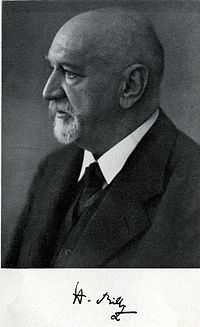Heinrich Biltz
| Heinrich Biltz | |
|---|---|
 Heinrich Biltz | |
| Born |
May 26, 1865 Berlin, Germany |
| Died |
October 29, 1943 Breslau, Germany |
| Residence | Germany |
| Nationality | German |
| Institutions |
University of Greifswald, University of Kiel, University of Breslau, |
| Alma mater | University of Göttingen |
| Doctoral advisor | Victor Meyer, |
| Doctoral students | Wilhelm Klemm |
| Known for |
Synthesis of Phenytoin; reactions of Acetylene and Autoxidation Oxidative degradation of Uric Acid |
Heinrich Biltz (born May 26, 1865 in Berlin, died October 29, 1943 in Breslau) was a German chemist and professor.
Life and career
Heinrich Biltz was the son of Karl Friedrich Biltz who was a literary scholar and theatre critic His brother Wilhelm Biltz was also a noted chemist.
After his university entrance diploma at the Royal Grammar School (Königliches Wilhelm-Gymnasium) in Berlin in 1885 he firstly began studying chemistry in the Humboldt University of Berlin with August Wilhelm von Hofmann and later in the University of Göttingen with Victor Meyer. In the year 1888 he awarded his doctor in natural science with the continuation of the researches commenced by Victor Meyer on the molecular weight of substances at high temperatures. During this time he determined also the vapour density from Tin (II) chloride and Sulphur.[1]
Since July 8, 1891 he firstly was professor of chemistry in the University of Greifswald and from 1897 succeeded as the Chair of the Department of Inorganic Chemistry in the University of Kiel and continued his research activities on the field of the determination of vapour density. In 1908 he also succeeded in the synthesis of Phenytoin, which was used 30 years later as an effective drug for the control of seizure disorders. From autumn 1911 until his retirement in 1933 he lectured in the newly arranged Albert Ladenburg Institute of the University of Breslau (Wroclaw) with the main emphasis on chemical reactions of organic substances, especially the reactions of Acetylene and Autoxidation.[2] He concentrated his further research activities on the chemistry of Uric Acid. He achieved and proved the complete oxidative degradation of Uric Acid with several oxidising agents.[3]
His work was interrupted when he participated in World War I as reserve officer. After the war he took up his research activities considerably and from time to time in close co-operation with his younger brother Wilhelm Biltz, who was also professor of chemistry, and with further renowned chemists.
The German Chemical Industry established in 1925 the Heinrich-Biltz- Foundation which was destined to support highly skilled students. In honour of the merits of Heinrich Biltz, Walter Hückel issued an obituary in the journal Chemische Berichte and annexed a complete bibliography of his work.
He married Freya de la Motte Fouqué, a daughter of a physician in Kiel. This marriage remained childless.
Publications and Books (options)
- Biltz, Heinrich: ‚"Experimentelle Einführung in die Unorganische Chemie". Veit & Comp, Leipzig, later Walter de Gruyter. - Berlin [u. a.] 1. Aufl. 1898, 20. Auflage 1938, later continued by Wilhelm Klemm u. Werner Fischer
- Biltz, Heinrich: "Qualitative Analyse unorganischer Substanzen", 1. Auflage 1900, 13 und 14. Auflage 1936; Veit & Comp, Leipzig, later Walter de Gruyter
- Biltz, Heinrich; Biltz, Wilhelm: "Übungsbeispiele aus der unorganischen Experimentalchemie", 1. Auflage 1907; 3.und 4. Auflage 1920; Engelmann, Leipzig
- Heinrich Biltz works in Wiley Interscience:[4]
- Publications of and about Heinrich Biltz in the catalogue of the German National Library:[19]
References
- ↑ "Experimentelle Einführung in die Anorganische Chemie"; (Klemm/Fischer), Walter de Gruyter; Berlin, 20. Auflg. 1985;
- ↑ "Ausführung quantitativer Analysen"; 10. Aufl. Stuttgart 1983;
- ↑ "Die neue Harnsäurechemie,Tatsachen und Erklärungen"; J. A. Barth, Leipzig, 1936;
- ↑ Works in Wiley Interscience
- ↑ Library of Congress LCCN Permalink for 48027290 at lccn.loc.gov
- ↑ Library of Congress LCCN Permalink for ac39000760 at lccn.loc.gov
- ↑ Library of Congress LCCN Permalink for 09029810 at lccn.loc.gov
- ↑ Library of Congress LCCN Permalink for med47001931 at lccn.loc.gov
- ↑ Library of Congress LCCN Permalink for 09016564 at lccn.loc.gov
- ↑ Library of Congress LCCN Permalink for 51045195 at lccn.loc.gov
- ↑ Library of Congress LCCN Permalink for 66075678 at lccn.loc.gov
- ↑ Library of Congress LCCN Permalink for 58040658 at lccn.loc.gov
- ↑ Library of Congress LCCN Permalink for 28020360 at lccn.loc.gov
- ↑ Library of Congress LCCN Permalink for 53031507 at lccn.loc.gov
- ↑ Library of Congress LCCN Permalink for 99004874 at lccn.loc.gov
- ↑ Library of Congress LCCN Permalink for unk83038172 at lccn.loc.gov
- ↑ Library of Congress LCCN Permalink for 66098632 at lccn.loc.gov
- ↑ Library of Congress LCCN Permalink for 51045802 at lccn.loc.gov
- ↑ https://portal.d-nb.de/opac.htm?method=simpleSearch&query=biltz%2C+heinrich
- Archive documents Hans-Thorald Michaelis, (Nephew)
- Hans-Thorald Michaelis:‚ "Die Gebrüder Heinrich und Wilhelm Biltz und ihre Vorfahren". ("The brothers Heinrich and Wilhelm Biltz and their ancestors"); Mitteldeutsche Familienkunde Band 6, 21. Jhrg. (1980), Heft 3, S. 231-303
- Walter Hückel: "Heinrich Biltz in memoriam", in the journal Chemische Berichte, 82. Jhrg. (1949), Nr. 6, S. 67-88
|